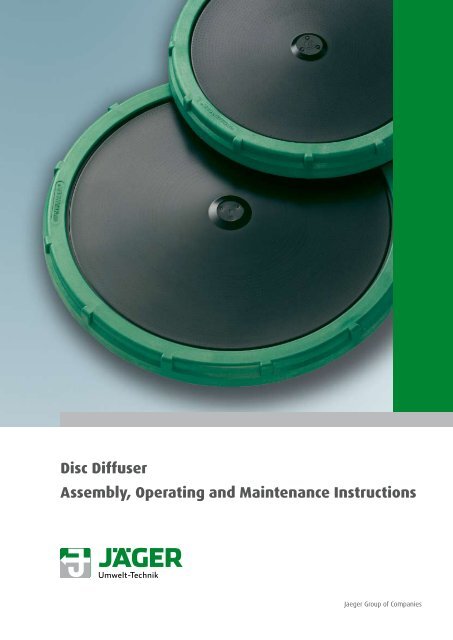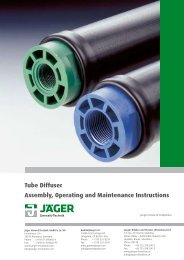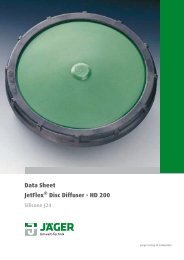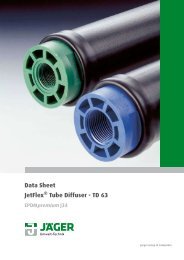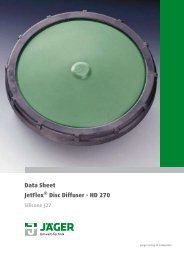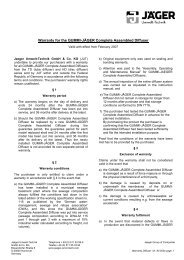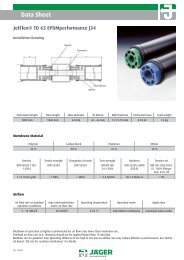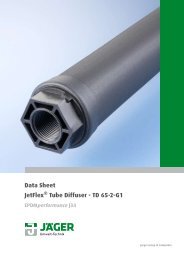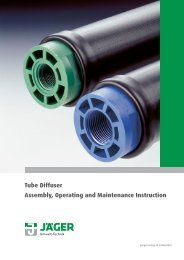Disk Diffuser - Jäger Umwelt-Technik GmbH & Co. KG
Disk Diffuser - Jäger Umwelt-Technik GmbH & Co. KG
Disk Diffuser - Jäger Umwelt-Technik GmbH & Co. KG
You also want an ePaper? Increase the reach of your titles
YUMPU automatically turns print PDFs into web optimized ePapers that Google loves.
Disc <strong>Diffuser</strong>Assembly, Operating and Maintenance InstructionsJaeger Group of <strong>Co</strong>mpanies
Specifications1 AERATION SYSTEMS. . . . . . . . . . . . . . . . . . . . . . . . . . . . . . . . . . . . . . . . . . . . . . . . . . . . . . . . 32 GENERAL. . . . . . . . . . . . . . . . . . . . . . . . . . . . . . . . . . . . . . . . . . . . . . . . . . . . . . . . . . . . . . . . 33 SHIPMENT . . . . . . . . . . . . . . . . . . . . . . . . . . . . . . . . . . . . . . . . . . . . . . . . . . . . . . . . . . . . . . . 34 INCOMING INSPECTION . . . . . . . . . . . . . . . . . . . . . . . . . . . . . . . . . . . . . . . . . . . . . . . . . . . . . 35 STORAGE OF EQUIPMENT. . . . . . . . . . . . . . . . . . . . . . . . . . . . . . . . . . . . . . . . . . . . . . . . . . . . 36 ASSEMBLY. . . . . . . . . . . . . . . . . . . . . . . . . . . . . . . . . . . . . . . . . . . . . . . . . . . . . . . . . . . . . . . 46.1 PREPARATIONS . . . . . . . . . . . . . . . . . . . . . . . . . . . . . . . . . . . . . . . . . . . . . . . . . . . . . . . . . . . . 46.2 DIFFUSER ALIGNMENT . . . . . . . . . . . . . . . . . . . . . . . . . . . . . . . . . . . . . . . . . . . . . . . . . . . . . . . 46.3 INSTALLATION . . . . . . . . . . . . . . . . . . . . . . . . . . . . . . . . . . . . . . . . . . . . . . . . . . . . . . . . . . . . . 47 OPERATING INSTRUCTIONS . . . . . . . . . . . . . . . . . . . . . . . . . . . . . . . . . . . . . . . . . . . . . . . . . . 57.1 START-UP INSTRUCTIONS . . . . . . . . . . . . . . . . . . . . . . . . . . . . . . . . . . . . . . . . . . . . . . . . . . . . . 57.2 REGULAR OPERATION . . . . . . . . . . . . . . . . . . . . . . . . . . . . . . . . . . . . . . . . . . . . . . . . . . . . . . . 57.3 TROUBLE SHOOTING. . . . . . . . . . . . . . . . . . . . . . . . . . . . . . . . . . . . . . . . . . . . . . . . . . . . . . . . . 67.4 MAINTENANCE AND CLEANING . . . . . . . . . . . . . . . . . . . . . . . . . . . . . . . . . . . . . . . . . . . . . . . . 77.4.1 MAINTENANCE . . . . . . . . . . . . . . . . . . . . . . . . . . . . . . . . . . . . . . . . . . . . . . . . . . . . . . . . . . . 77.4.2 MECHANICAL CLEANING . . . . . . . . . . . . . . . . . . . . . . . . . . . . . . . . . . . . . . . . . . . . . . . . . . . . 77.4.3 CHEMICAL CLEANING . . . . . . . . . . . . . . . . . . . . . . . . . . . . . . . . . . . . . . . . . . . . . . . . . . . . . . 78 REPLACEMENTS . . . . . . . . . . . . . . . . . . . . . . . . . . . . . . . . . . . . . . . . . . . . . . . . . . . . . . . . . . . 79 RECYCLING . . . . . . . . . . . . . . . . . . . . . . . . . . . . . . . . . . . . . . . . . . . . . . . . . . . . . . . . . . . . . 810 DISCLAIMER . . . . . . . . . . . . . . . . . . . . . . . . . . . . . . . . . . . . . . . . . . . . . . . . . . . . . . . . . . . . . 811 REFERENCE . . . . . . . . . . . . . . . . . . . . . . . . . . . . . . . . . . . . . . . . . . . . . . . . . . . . . . . . . . . . . . 8
Specifications6. Assembly6.1 Preparations• Prior to assembly of the aeration system remove all debris (stones, metal scrap, wooden piecesetc.) from the aeration tank.• Recommended laterals are standard plastic pipes (PVC or tempered PE) schedule 40 to schedule80. Choose grommet size corresponding to wall thickness of lateral.• All laterals must be levelled within ± 6.35 mm (± 1/4”) for proper function of diffusers.• Air outlet holes in lateral for each diffuser must be predrilled and adjusted in accordance to theindividual data sheets. Hole diameter ± 0.1 mm, vertical alignment of holes within ± 3°.• Deburr all holes.• Remove all internal debris from within the laterals with a water flush through the laterals.6.2 <strong>Diffuser</strong> AlignmentKeep enough distance to water accelerators (propellers etc.). Water velocity at diffusers must notexceed 0.5 m/s.6.3 Installation• To ease insertion the grommet may be wetted with a lubricant. Recommended lubricants arecommercial-grade water-based soap (5 - 10%) or regular household detergents (0.01 to 0.1%).Do not use lubricants containing mineral oils or other hydrocarbons.• Press the grommet into the hole and turn it back and forth until the grommet snaps into theopening. A slightly loose fit is OK.• Press the disc with its NPT-thread into the grommet; turn the disc clockwise until the lower rimof the disc sets onto the lateral piping. Use the special offset fork wrench (JUT # 12013) to avoidrotation of the grommet.• Do not twist the disc’s membrane.• The grommet must not be deformed during insertion of disc. Unscrew disc and tighten again ifnecessary. Use new grommets for damaged ones.
Specifications7 Operating Instructions7.1 Start-Up InstructionsPrior to start-up clean the aeration tank from debris like stones, wooden pieces, metal parts etc.Keep the time between assembly and filling of the basin as short as possible. Ohterwise take thefollowing steps:• Do not perform any work near the diffuser or above the aeration tank, which may damagediffusers; e.g. painting, welding, concrete sealing etc.• Safeguard diffusers from falling parts.• Fill tank with clean water approximately 20 cm above diffusers. Start blowers for 5 - 10minutes and check for obvious leaks. Have blowers stopped and immediately check again for smaller andhidden leaks when airflow seizes. Tiny leaks may be detected now with lower turbulences.• Start wastewater treatment now or raise water level to 1 m with clean water.• Operate blowers for 10 minutes at medium speed at least once a day.• Raise water level even more if temperatures drop below freezing. (~20 cm additional water foreach degree Celsius below zero.)• Prior to SOTE testing allow diffusers to run at maximum design airflow for one week (minimum 3days).7.2 Regular OperationDuring regular operation adjust airflow of diffusers to maintain the required oxygen level in theaeration tank. Keep airflow within recommended range of diffusers (see data sheets).Too high an airflow reduces efficiency and may eventually damage the diffuser membraneirreversibly. Very low airflow rates may cause uneven oxygen supply and excessive fouling of themembrane surface. Water temperature should range from 5°C to 35°C; air temperature at the diffusershould not exceed 60°C. <strong>Co</strong>nsult JUT in case either temperature is higher.Air from blowers must not contain oil, dust, or solvents. Use dust filters according to DIN EN 779 (>80%,better >90% dust removal, class G3 or G4, respectively.) Air going into the blowers must correspondto local regulations (see e.g. TA-Luft for Germany).<strong>Diffuser</strong> headloss should be monitored continuously. An increase of more than 10 mbar/year may indicatea clogging problem caused by deposits of carbonates, iron-salts, or biological growth. See section7.4 for details of cleaning. Inspect diffusers visually on a regular basis at least once a year.
Specifications7.3 Trouble ShootingJetFlex <strong>Diffuser</strong>s need very little maintenance even for long-term operation due to theirhigh-performance materials. JUT recommends regular inspection intervals every 12 to 18 months inorder to monitor fouling processes. Check pressure loss permanently with accurate pressure gauges,an increase of more than 20 mbar per year may indicate fouling or other problems.The most common problems and their recommended corrections are:1. Indication: Large volume of air in localized areaPossible cause:Leakage in lateral pipingProcedure:Drain basin to access area in question, maintain medium air flow, checkjoints and pipes for evidence of breakage, repair or exchangePossible cause:<strong>Diffuser</strong> membrane is damaged or missingProcedure:Drain basin to access area in question, maintain medium air flow,inspect visually diffuser, exchange membrane or complete diffuser2. Indication: Non uniform bubble patternPossible cause:Insufficient blower capacityProcedure:<strong>Co</strong>nfirm blower operations, switch on additional blowersPossible cause:Valve of drop lines closed or not open enoughProcedure:Inspect position of check valvePossible cause:Incomplete air distribution to diffusersProcedure:Drain basin to access area in question, check diffuser horizontallevelling, level within tolerance of ± 0,6 cm / ± 1/4”, inspect piping andjoints for inter- nal clogging from debris, air purge or water flushcleaningPossible cause:Deposits on diffuser membraneProcedure:Inspect diffuser membranes for deposits and encrustation, clean orexchange membrane or exchange diffuser3. Indication: Decreasing of dissolved oxygen level, increase of system pressuredropPossible cause:Deposits on diffuser membraneProcedure:Inspect diffuser membranes for deposits and encrustation, clean orexchange membrane or exchange diffuser4. Indication: Non uniform dissolved oxygen profile throughout basinPossible cause:Insufficient air volumeProcedure:<strong>Co</strong>nfirm blower operations, switch on additional blowers, checkequipment and operation conditions, see 1-3Depending on type of waste, individual constructions and operation conditions other causes can leadto disturbances. If necessary contact the contractor or engineering office.
Specifications7.4 Maintenance and Cleaning7.4.1 MaintenanceCheck aeration continuously during regular operation for non-uniform bubble pattern and higher thanexpected headloss. Depending on the type of wastewater, treatment process, and operating conditionsfouling of membranes may occur, thus reducing oxygen transfer. Remove deposits from membraneregularly, at least once a year. Sludge must not dry on the surface of the membrane, once hardenedthe sludge sticks to the membrane and will clog diffus-ers permanently.7.4.2 Mechanical CleaningDeposits on membranes can be removed just with the use of a good household scrubber, brushgently and flush generously with a water hose. If necessary use a pressure-washer 1 instead, but keepa minimum distance of about 50 cm to the membrane and set the nozzle to a broad spray and not toa sharp jet.Pressure washer are recommended to remove fouling from aluminium- and/or iron-salts used forprecipitation of phosphor from the wastewater. The chemicals themselves do not attack the surface ofthe membrane but may sometimes cause additional fouling.7.4.3 Chemical Cleaning 2Certain deposits (CaCO 3) can be removed during regular operation – without stopping the treatmentprocess – by adding formic acid (HCOOH) into the air-stream. Depending on the degree of fouling spray10 cm³ of HCOOH (50% to 85% concentration) into each m³ Nof air (at normal conditions) for about 30to 60 minutes. Set airflow to maximum design airflow for diffusers used; see individual data sheetsfor details. Keep airflow high for another two hours in order to remove any condensed 3 HCOOH fromthe laterals and diffusers.The exact amount of acid and details of the cleaning process must be determined beforehand byappropriate tests.8 ReplacementsEither the membrane only or the entire diffusers should be replaced whenever necessary. Exchange ofmembrane typically takes more time, so usually installing new diffuses makes economic sense.• Remove sludge from diffusers with pressure-washer 1 .• Unscrew diffuser and remove grommet by hand, do not use tools!• Do not damage the hole in the lateral.• Clean sealing area and connector, use new grommet.• Mount new diffusers as described in chapter 6.3.• Run leak-test as described in chapter 7.1.1)Follow safety guidelines of manufacturer of pressure-washer.2)Formic acid is dangerous and can cause severe injuries and death. Professional equipment and specially trainedpersonel required. Follow all safety instructions and MSDS recommondations with the use of formic acid.3)HCOOH has a vapour point of 106°C, so even a fine mist will not vaporize entirely. It is therefore advised to removemost of the condensed water in laterals before starting the acid-cleaning process.
Specifications9. RecyclingObserve all local and federal regulations for waste deposit at time of disposal. Clamps may be disposedof as scrap metal. In case of contamination check with authorities and/or a certified wastemanagement consultant.10. DisclaimerThis information is based on our present state of knowledge and is intended to provide generalnotes on our products and their uses. It should not therefore be construed as guaranteeing specificproperties of the products described or their suitability for a particular application. US units are forconvenience only. Any existing industrial property rights must be observed. The quality of our productsis guaranteed under our General <strong>Co</strong>nditions of Sale.11. Reference• DIN 7716, Erzeugnisse aus Kautschuk und Gummi, Anforderungen an die Lagerung, Reinigungund Wartung, Beuth Verlag, Berlin 1982.• TA Luft, Technische Anleitung zur Reinhaltung der Luft, 1986.• DWA-M 115, Indirekteinleitung nicht häuslichen Abwassers, DWA, Hennef, 2004• ATV M-209, Messung der Sauerstoffzufuhr von Belüftungseinrichtungen in Belebungsanlagenin Reinwasser und in belebten Schlamm, Gesellschaft zur Förderung der Abwassertechnik e.V.(GFA), Hennef 1996.• PrEN 12255-15, Wastewater treatment plants - Part 15: Measurement of the oxygen transfer inclean water in activated sludge aeration tanks, European <strong>Co</strong>mmittee For Standardization, Brussels,1999. ANSI/ASCE 2-91, Measurement of Oxygen Transfer in Clean Water, American Society of CivilEngineers, New York, 1992.<strong>Jäger</strong> <strong>Umwelt</strong>-<strong>Technik</strong> <strong>GmbH</strong> & <strong>Co</strong>. <strong>KG</strong>Kreisstrasse 24 c30629 Hannover, GermanyPhone: (+49)511 898668-0Fax: (+49)511 898668-99www.jaeger-envirotech.cominfo@jaeger-envirotech.comGummiJaeger LLC.14300 I-25 Frontage Rd.Longmont, CO 80504, USAPhone: +1 970 535-0554Fax: +1 970 535-0945www.gummijaeger.cominfo@gummijaeger.comJaeger Rubber and Plastics (Shenzhen) Ltd.1/F, No. A13 Factory BuildingSilicon Valley – Automobile Industry ParkGuanlan, Baoan, Shenzhen,China 518110Phone: +86 755 29832412Fax: +86 755 29832413www.jaeger-shenzhen.cninfo@jaeger-shenzhen.cnJUT_2007_08


